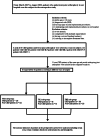A Retrospective Study of the Perioperative Period Management of Joint Arthroplasty in Patients with Chronic Kidney Disease
- PMID: 36453119
- PMCID: PMC9891927
- DOI: 10.1111/os.13589
A Retrospective Study of the Perioperative Period Management of Joint Arthroplasty in Patients with Chronic Kidney Disease
Abstract
Objective: With the rising prevalence of chronic kidney disease (CKD) and the increasing demand for joint arthroplasty, the management of CKD patients in the perioperative period of joint arthroplasty has become an issue worthy of attention for orthopedic surgeons. This study aimed to explore comprehensive perioperative period management strategies for CKD patients.
Methods: From March 2017 to August 2022, 62 patients who underwent joint arthroplasty in our hospital were included in a retrospective study, including 31 CKD patients (mean age 69.8 ± 13.4 years old) and 31 non-CKD patients (mean age 69.4 ± 14.2 years old). The outcome indicators were analyzed, including serum urea, serum creatinine, blood uric acid, hematocrit, and hemoglobin.
Results: All patients included in the retrospective study had an average preoperative preparation time of 4.3 ± 2.6 days and an average hospitalization time of 11.0 ± 7.3 days. There were no significant differences in the changes in the serum urea values between the preoperative and postoperative measurements in the CKD patients or in the serum creatinine values and blood uric acid values (P > 0.05). The hemoglobin value in postoperative measurements was lower than in preoperative measurements in the CKD patients (P < 0.05). The hematocrit value in postoperative measurements was lower than in preoperative measurements in the CKD patients (P < 0.001).
Conclusion: Patients with CKD have distinct characteristics compared to non-CKD patients, and they generally have a higher risk for postoperative complications and adverse events. Recognition of risk factors, suitable timing of surgery, the undertaking of protective strategies, and proper management of complications are vital for managing CKD patients in the perioperative period of joint arthroplasty.
Keywords: Chronic kidney disease; Joint arthroplasty; Perioperative period; Renal function.
© 2022 The Authors. Orthopaedic Surgery published by Tianjin Hospital and John Wiley & Sons Australia, Ltd.
Figures







References
-
- Ma Y, Fang K, Gang S, et al. Occurrence and predictive factors of acute renal injury following hip and knee arthroplasty. Clin Exp Nephrol. 2020;24(7):598–605. - PubMed
-
- Zhang Y, Shao Y, Liu H, et al. Influence of chronic kidney disease on patients undergoing elective hip and knee orthopedic surgery: a systematic review and meta‐analysis. J Invest Surg. 2021;34(3):346–56. - PubMed
-
- Sun K, Fan M, Jaing W. Can total joint arthroplasty be safely performed in patients with chronic kidney disease? J Am Podiatr Med Assoc. 2021;111(5):10.7547/20‐007. - PubMed
-
- Cavanaugh PK, Chen AF, Rasouli MR, Post ZD, Orozco FR, Ong AC. Complications and mortality in chronic renal failure patients undergoing total joint arthroplasty: a comparison between dialysis and renal transplant patients. J Arthroplasty. 2016;31(2):465–72. - PubMed
-
- Ackland GL, Moran N, Cone S, Grocott MP, Mythen MG. Chronic kidney disease and postoperative morbidity after elective orthopedic surgery. Anesth Analg. 2011;112(6):1375–81. - PubMed
MeSH terms
Substances
Grants and funding
- 82072506/National Natural Science Foundation of China
- 81874030/National Natural Science Foundation of China
- 82272611/National Natural Science Foundation of China
- 2021RC3025/Hunan Young Talents of Science and Technology
- 2020SK53709/Provincial Clinical Medical Technology Innovation Project of Hunan
- 2020CX045/Innovation-Driven Project of Central South University
- 320.6750.2020-03-14/Wu Jieping Medical Foundation
- 2021KFJJ02/National Clinical Research Center for Geriatric Disorders
- 2021-NCRC-CXJJ-PY-40/National Clinical Research Center for Orthopedics, Sports Medicine and Rehabilitation
- XCX2021046/Exploration and Innovation Project for Undergraduate Students of Central South University
LinkOut - more resources
Full Text Sources
Medical

